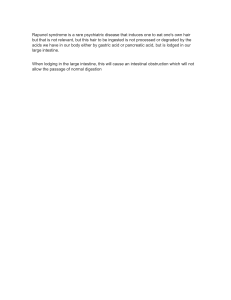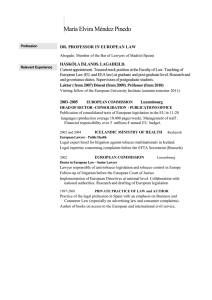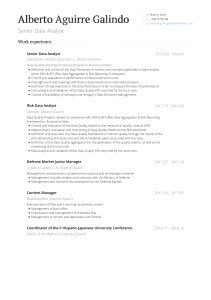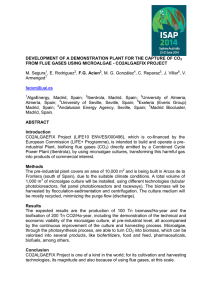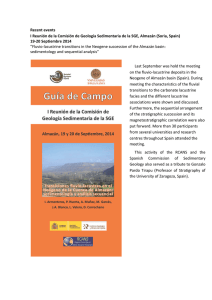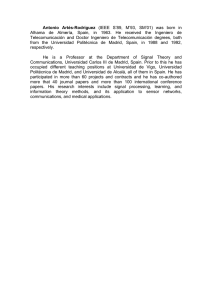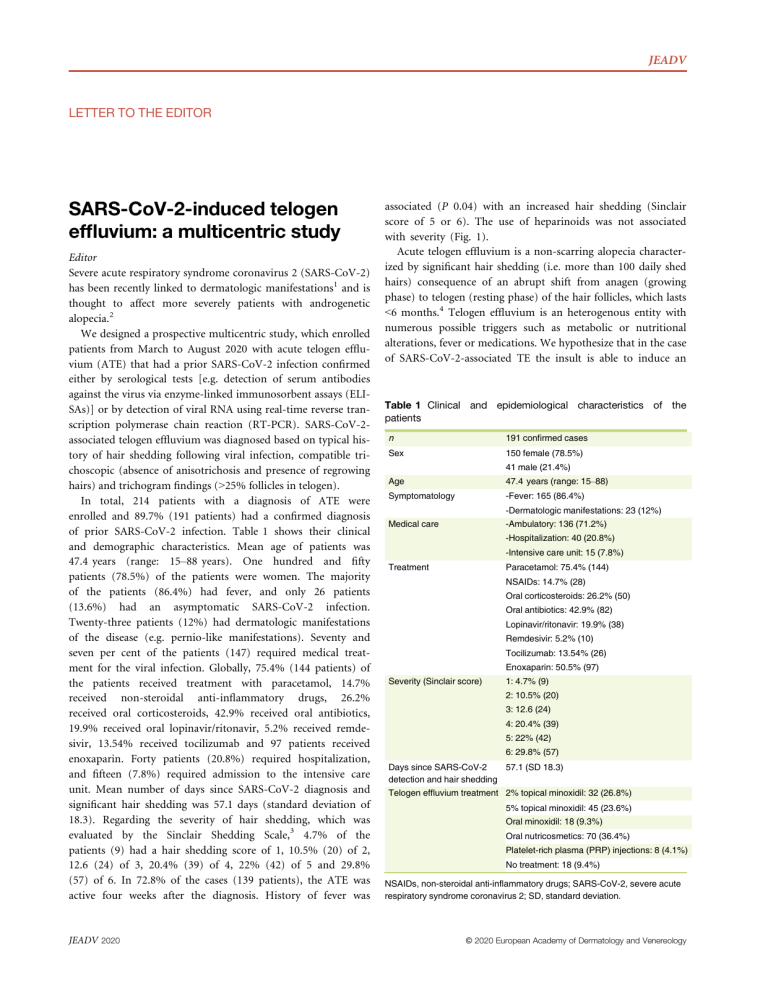
JEADV LETTER TO THE EDITOR SARS-CoV-2-induced telogen effluvium: a multicentric study Editor Severe acute respiratory syndrome coronavirus 2 (SARS-CoV-2) has been recently linked to dermatologic manifestations1 and is thought to affect more severely patients with androgenetic alopecia.2 We designed a prospective multicentric study, which enrolled patients from March to August 2020 with acute telogen effluvium (ATE) that had a prior SARS-CoV-2 infection confirmed either by serological tests [e.g. detection of serum antibodies against the virus via enzyme-linked immunosorbent assays (ELISAs)] or by detection of viral RNA using real-time reverse transcription polymerase chain reaction (RT-PCR). SARS-CoV-2associated telogen effluvium was diagnosed based on typical history of hair shedding following viral infection, compatible trichoscopic (absence of anisotrichosis and presence of regrowing hairs) and trichogram findings (>25% follicles in telogen). In total, 214 patients with a diagnosis of ATE were enrolled and 89.7% (191 patients) had a confirmed diagnosis of prior SARS-CoV-2 infection. Table 1 shows their clinical and demographic characteristics. Mean age of patients was 47.4 years (range: 15–88 years). One hundred and fifty patients (78.5%) of the patients were women. The majority of the patients (86.4%) had fever, and only 26 patients (13.6%) had an asymptomatic SARS-CoV-2 infection. Twenty-three patients (12%) had dermatologic manifestations of the disease (e.g. pernio-like manifestations). Seventy and seven per cent of the patients (147) required medical treatment for the viral infection. Globally, 75.4% (144 patients) of the patients received treatment with paracetamol, 14.7% received non-steroidal anti-inflammatory drugs, 26.2% received oral corticosteroids, 42.9% received oral antibiotics, 19.9% received oral lopinavir/ritonavir, 5.2% received remdesivir, 13.54% received tocilizumab and 97 patients received enoxaparin. Forty patients (20.8%) required hospitalization, and fifteen (7.8%) required admission to the intensive care unit. Mean number of days since SARS-CoV-2 diagnosis and significant hair shedding was 57.1 days (standard deviation of 18.3). Regarding the severity of hair shedding, which was evaluated by the Sinclair Shedding Scale,3 4.7% of the patients (9) had a hair shedding score of 1, 10.5% (20) of 2, 12.6 (24) of 3, 20.4% (39) of 4, 22% (42) of 5 and 29.8% (57) of 6. In 72.8% of the cases (139 patients), the ATE was active four weeks after the diagnosis. History of fever was JEADV 2020 associated (P 0.04) with an increased hair shedding (Sinclair score of 5 or 6). The use of heparinoids was not associated with severity (Fig. 1). Acute telogen effluvium is a non-scarring alopecia characterized by significant hair shedding (i.e. more than 100 daily shed hairs) consequence of an abrupt shift from anagen (growing phase) to telogen (resting phase) of the hair follicles, which lasts <6 months.4 Telogen effluvium is an heterogenous entity with numerous possible triggers such as metabolic or nutritional alterations, fever or medications. We hypothesize that in the case of SARS-CoV-2-associated TE the insult is able to induce an Table 1 Clinical and epidemiological characteristics of the patients n 191 confirmed cases Sex 150 female (78.5%) 41 male (21.4%) Age 47.4 years (range: 15–88) Symptomatology -Fever: 165 (86.4%) -Dermatologic manifestations: 23 (12%) Medical care -Ambulatory: 136 (71.2%) -Hospitalization: 40 (20.8%) -Intensive care unit: 15 (7.8%) Treatment Paracetamol: 75.4% (144) NSAIDs: 14.7% (28) Oral corticosteroids: 26.2% (50) Oral antibiotics: 42.9% (82) Lopinavir/ritonavir: 19.9% (38) Remdesivir: 5.2% (10) Tocilizumab: 13.54% (26) Enoxaparin: 50.5% (97) Severity (Sinclair score) 1: 4.7% (9) 2: 10.5% (20) 3: 12.6 (24) 4: 20.4% (39) 5: 22% (42) 6: 29.8% (57) Days since SARS-CoV-2 57.1 (SD 18.3) detection and hair shedding Telogen effluvium treatment 2% topical minoxidil: 32 (26.8%) 5% topical minoxidil: 45 (23.6%) Oral minoxidil: 18 (9.3%) Oral nutricosmetics: 70 (36.4%) Platelet-rich plasma (PRP) injections: 8 (4.1%) No treatment: 18 (9.4%) NSAIDs, non-steroidal anti-inflammatory drugs; SARS-CoV-2, severe acute respiratory syndrome coronavirus 2; SD, standard deviation. © 2020 European Academy of Dermatology and Venereology Letter to the Editor 2 Conflicts of interest None. Funding sources None. O.M. Moreno-Arrones,1,2,* A. Lobato-Berezo,3 A. Gomez-Zubiaur,4,5 S. Arias-Santiago,6 D. Saceda-Corralo,1,2 C. Bernardez-Guerra,7 R. Grimalt,8 9 P. Fernandez-Crehuet, J. Ferrando,10 R. Gil,11 A. Hermosa-Gelbard,1,2 R. Rodrigues-Barata,1,2 D. Fernandez-Nieto,1 S. Merlos-Navarro,12 ~o -Galva n1,2 S. Van 1 Figure 1 Patient with SARS-CoV-2-induced telogen effluvium. Note the reduced hair density on the temple. 1051 9 1137 mm (72 9 72 DPI). immediate anagen release of the hair follicles, which switch to catagen phase and subsequently enter telogen. Pro-inflammatory cytokines released during the infection context are probably the trigger of the TE although drugs (e.g. heparinoids) could also be implicated. Collected data from these patients suggest that a symptomatic SARS-CoV-2 infection is a risk factor for the development of ATE and physicians could warn patients of this possible outcome. It also should be pointed out that approximately 1 in 10 patients suffered ATE with a subclinical SARS-CoV-2 infection, and therefore, in the context of the pandemic, past SARS-CoV-2 infection should be considered in every patient consulting for ATE. In addition, as the information regarding time of onset and severity is similar to other infection-induced ATE,5 it is reasonable to think that the evolution and prognosis are similar, and therefore, even without any specific treatment, full recovery of lost hair is expected. Dermatology Department, Trichology Unit, Ramon y Cajal University n y Cajal de Investigacio n Sanitaria (IRYCIS), Hospital, Instituto Ramo University of Alcala, Madrid, Spain, 2Trichology and Hair Transplantation Unit, Grupo Pedro Jaen Clinic, Madrid, Spain, 3Servicio Dermatologıa, Hospital del Mar-Parc de Salut Mar, Barcelona, Spain, 4Servicio Dermatologıa, Hospital Universitario Prıncipe de Asturias, Madrid, Spain, 5 Unidad de Tricologıa, Instituto M edico Ricart, Madrid, Spain, 6Servicio de Dermatologıa, Hospital Universitario Virgen de las Nieves, Granada, Spain, 7 Grupo Dermatologıa Pedro Jaen, Hospital Ruber Juan Bravo, Madrid, Spain, 8Facultat de Medicina i Ci encies de la Salut, Universitat s (Barcelona), Spain, Internacional de Catalunya, Sant Cugat del Valle 9 ndez-Crehuet and Hospital Dermatology Department, Clinica Ferna rdoba, Spain, 10Honorary Professor of Universitario Reina Sofia, Co Dermatology, University of Barcelona, Barcelona, Spain, 11Dermatology, Hospital Universitario La Paz, Madrid, Spain, 12Servicio de Neumologıa, Hospital Universitario Virgen de las Nieves, Granada, Spain *Correspondence: O.M. Moreno-Arrones. E-mail: o.m.m. [email protected] References 1 Fahmy DH, El-Amawy HS, El-Samongy MA et al. COVID-19 and dermatology: a comprehensive guide for dermatologists. J Eur Acad Dermatol Venereol 2020; 34: 1388–1394. 2 Wambier CG, Va~ no-Galvan S, McCoy J et al. Androgenetic alopecia present in the majority of patients hospitalized with COVID-19: the “Gabrin sign”. J Am Acad Dermatol 2020; 83: 680–682. 3 Sinclair R. Hair shedding in women: how much is too much? Br J Dermatol 2015; 173: 846–848. 4 Malkud S. Telogen effluvium: a review. J Clin Diagn Res 2015; 9: WE01– WE03. 5 Bernstein GM, Crollick JS, Hassett JM. Postfebrile telogen effluvium in critically ill patients. Crit Care Med 1988; 16: 98–99. DOI: 10.1111/jdv.17045 Acknowledgement The patients in this manuscript have given written informed consent to the publication of their case details. JEADV 2020 © 2020 European Academy of Dermatology and Venereology

